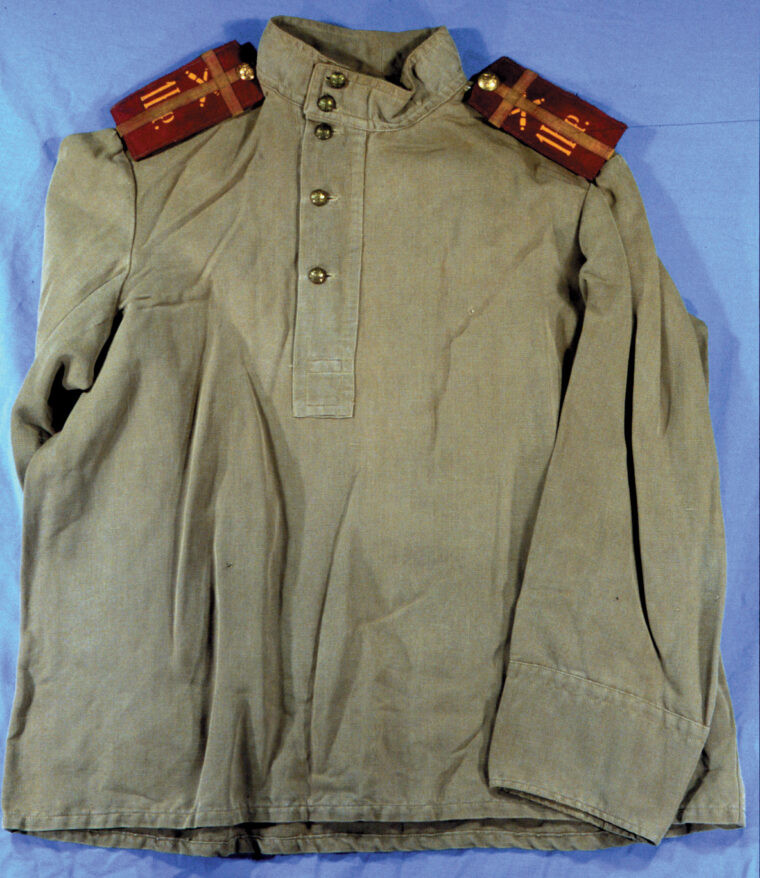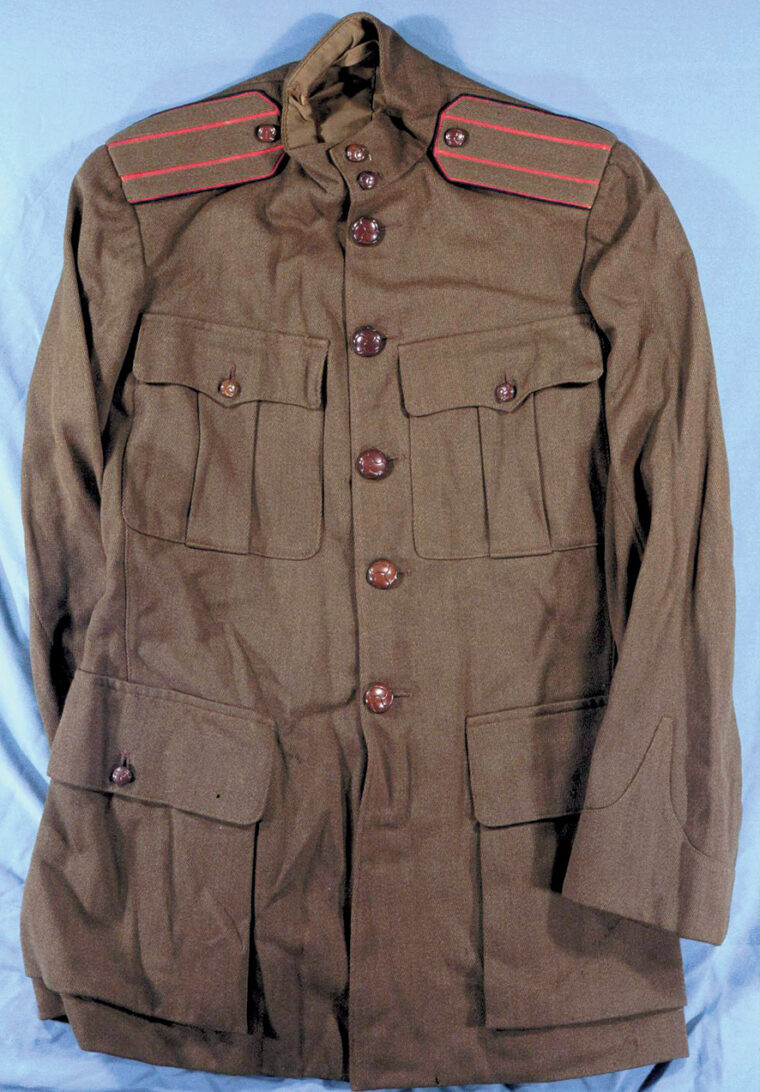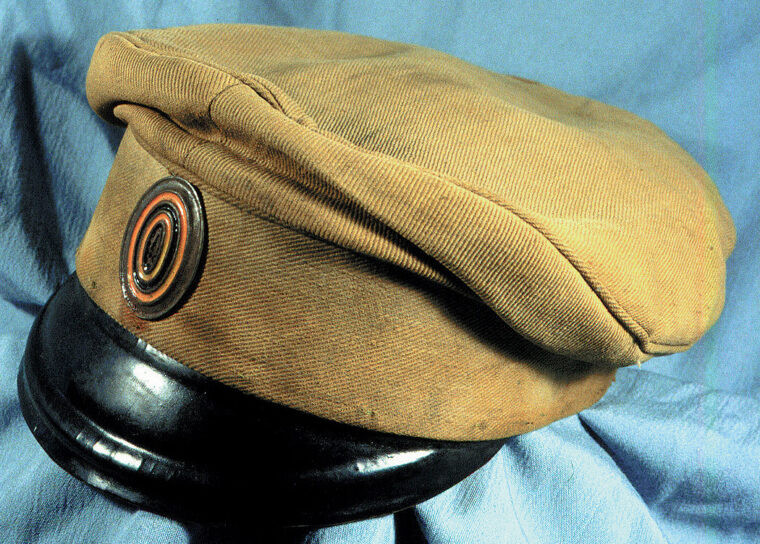The uniforms of the Imperial Russian Army during World War I, often overshadowed by their Western counterparts, offer a fascinating glimpse into the challenges and complexities of a nation at war. While perhaps lesser-known than the iconic Stahlhelms of Germany or the Brodie helmets of Britain, the Ww1 Russian Uniform tells a story of resourcefulness, improvisation, and the harsh realities faced by the Czar’s forces. This article delves into the intricacies of these field uniforms, exploring their evolution, variations, and the factors that contributed to their unique character.
The Pre-War Foundation: 1907 Khaki Uniform
Following the Russo-Japanese War, the Russian military recognized the critical need for camouflage in modern warfare. This led to the introduction of a khaki field uniform in 1907, a significant departure from the brightly colored uniforms of the past. This pre-war WW1 Russian uniform established the basic patterns that would be adapted and modified throughout the conflict.
The Kitel: Service Coat for the Ranks
For enlisted ranks, the 1907 uniform featured a service coat known as the kitel. This tunic was characterized by a stand collar, a five-button front, and two lower pockets. It was designed for practicality in the field, reflecting the growing understanding of the need for functional military attire.
Officer Tunics: Distinctions and Branch Piping
Officers also wore a kitel-style service coat, but theirs was distinguished by the addition of two breast pockets, providing extra utility. Furthermore, officer’s tunics incorporated branch-of-service piping on the collar and cuffs, indicating their specific military branch. Cavalry officers were further distinguished by an inverted “v” shaped cuff, while most other officers had straight cuffs. Although described as khaki, the pre-war WW1 Russian uniform color was more accurately a green-gray shade. Officer’s uniforms were typically tailor-made from higher quality materials compared to the enlisted ranks, though both were considered superior to later Soviet-era fabrics.
The Gimnastorka: A Versatile Field Shirt
In 1912, the gimnastorka, a field shirt, was authorized for general issue across all ranks. This garment became a defining feature of the WW1 Russian uniform. Inspired by the traditional Russian peasant shirt, the gimnastorka was designed for comfort and practicality. It featured a stand collar and a placket with two or three buttons, positioned either in the middle or on the left side of the chest. Made from wool for winter and cotton for summer, the gimnastorka was typically unlined, emphasizing its functional nature.
 An Imperial Russian enlisted rank’s summer gimnastorka. BELOW: An enlisted rank’s summer field cap with cockade in national colors.
An Imperial Russian enlisted rank’s summer gimnastorka. BELOW: An enlisted rank’s summer field cap with cockade in national colors.
Variations in Style and Standardization Challenges
Despite official patterns, the WW1 Russian uniform gimnastorka exhibited considerable variations, highlighting the challenges of standardization within the vast Russian Empire. Unlike the mass-produced uniformity seen in the German or British armies, Russian uniforms reflected a more decentralized production system. Gimnastorkas could have two or three buttons on the placket, and variations in collar closures and cuff styles were common. The khaki color itself ranged across a spectrum of shades, from brown and tan to green and gray. Pocket styles also varied, with both patch and internal pockets, sometimes with flaps, being observed. Later in the war, officers adopted gimnastorkas with four pockets, mirroring the style of their tunics, further blurring the lines between officer and enlisted attire in terms of practicality.
Officer Tunics: Evolving Styles and the “French” Influence
Officer tunics also demonstrated stylistic variations, with differences in pockets, buttons, and overall cut. The pre-war kitel style persisted, but wartime pressures and influences brought about changes. The most significant wartime adaptation was the adoption of the “French” style tunic. Named after General French, commander of the British Expeditionary Force, this tunic was inspired by the practical field tunics worn by British officers. These “French” tunics typically featured a cotton lining and significantly larger pockets, often with pleats for increased capacity. Button choices were diverse, ranging from standard-sized buttons made of bone, wood, leather, or the Imperial double-headed eagle, to larger, plain buttons. Like the gimnastorka, the “French” tunic appeared in a range of khaki shades, reflecting the ongoing supply challenges and variations in dye lots.
 A Russian cavalry colonel’s “French” style field tunic made during WWI with wool cloth imported from England.
A Russian cavalry colonel’s “French” style field tunic made during WWI with wool cloth imported from England.
Supply Chain Strains and Uniform Diversity
The remarkable diversity seen in the WW1 Russian uniform was largely a consequence of the strained Russian supply system at the outset of the war. Initial war plans were based on a short conflict, leading to inadequate stockpiles of supplies. Russian industry struggled to meet the demands of mass mobilization, and the reliance on numerous small, geographically dispersed manufacturers further exacerbated the issue. This decentralized production, even with subcontractors for major suppliers, resulted in inconsistencies in adherence to official patterns and contributed significantly to the wide array of uniform variations.
Breeches, Trousers, and Field Caps
Variations extended beyond tunics and gimnastorkas to other essential uniform components. Breeches and straight-leg trousers, worn by both officers and enlisted men, came in varying shades of khaki and even dark blue, which was originally authorized for peacetime but saw wartime use. Officer’s breeches were distinguished by two stripes of branch piping along the outer seam, absent in enlisted ranks’ trousers.
The field cap, another crucial part of the WW1 Russian uniform, was made from wool or cotton with a medium-height crown and a visor of leather or composite material, typically black or khaki. Officers and some enlisted ranks wore a matching chinstrap. While pre-war caps had a reinforcing ring inside the crown, this was often removed in the field for comfort or practicality. Caps were lined with polished cotton and featured sweatbands made of leather or leatherette.
 An enlisted rank’s summer field cap with cockade in national colors.
An enlisted rank’s summer field cap with cockade in national colors.
Shoulder Straps: Rank and Unit Identification
Shoulder straps were a distinctive and essential element of the WW1 Russian uniform, serving to display both rank and unit affiliation for officers and enlisted men alike. The Russian rank system was complex, but shoulder straps provided a visual means of identification.
Officer Shoulder Straps: Metallic Braid and Rank Insignia
Officer’s shoulder straps were crafted from metallic braid, gold for combat arms and silver for technical and support branches. Regimental or branch-of-service piping was incorporated around the strap and woven into the braid. Company-grade officers displayed stars to indicate their rank, while field-grade officers, up to colonel, had stars removed progressively with increasing rank. Generals wore solid metallic braid straps.
Enlisted Shoulder Straps: Color and Unit Ciphers
Enlisted men’s shoulder straps were initially issued in regimental or branch-of-service colors, some being double-sided with khaki on the reverse. Warrant officers and non-commissioned officers were denoted by braid strips in different configurations. Crucially, all ranks’ straps displayed the number or cipher of their regiment, battery, or unit. These ciphers, often Cyrillic letters representing the unit name, were metal for officers and typically painted onto enlisted straps.
Wartime Khaki Straps and Continued Unit Identification
After the war’s outbreak in 1914, shoulder straps for all ranks were mandated to be khaki, eliminating branch-of-service colors, though unit ciphers and numbers continued to be worn. Like other uniform items, shoulder straps exhibited variations in manufacture, offering a challenge to collectors seeking authentic examples of the WW1 Russian uniform.
Boots and Field Equipment Shortages
Beyond uniforms and insignia, footwear was another defining, yet problematic, aspect of the WW1 Russian uniform. The iconic black leather boots, synonymous with the Russian soldier, were unfortunately in short supply at the war’s outset. The unprepared Russian quartermaster corps struggled to provide boots for the millions of mobilized soldiers, mirroring shortages in rifles and uniforms. Millions of pairs of boots had to be imported from the United States to address this critical deficiency.
The reliance on imports extended to other materials, including khaki cloth from Great Britain, highlighting the industrial limitations of Russia during the war. Officer’s “French” tunics were even made from wool gabardine identical to that used in British officer uniforms, further illustrating this dependence. Leather shortages also impacted the availability of basic field equipment.
Field Equipment: Variations and Authenticity
Enlisted ranks’ field equipment consisted of a brown leather belt with cartridge pouches, a brass mess kit, haversack, canteen, and a small shovel. Officers carried a belt with shoulder straps, a sword, canteen, map case, and pistol. Like uniforms, field equipment varied in detail depending on the manufacturer, adding to the complexity for collectors seeking authentic WW1 Russian uniform items and associated gear.
 A group of artillery officers dressed for the field with typical field equipment, circa 1915. The man at right is wearing an enlisted style gimnastorka.
A group of artillery officers dressed for the field with typical field equipment, circa 1915. The man at right is wearing an enlisted style gimnastorka.
Collecting Imperial Russian Uniforms Today
The variations and supply challenges inherent in the WW1 Russian uniform present unique difficulties for collectors. The lack of a single, consistently manufactured “benchmark” pattern makes authentication challenging. The market is further complicated by copies, some originating from Soviet film studios. While film studio stamps don’t automatically disqualify an item as original (as studios sometimes used original uniforms), the quality of materials in copies is generally inferior. Expertise in recognizing original materials and manufacturing details remains the best tool for determining authenticity.
Imperial Russian uniforms were never abundant, even within Russia itself. Years of wear and tear have taken their toll on the millions produced before 1917. Ironically, Russian émigré communities established after the Revolution have often proven to be better sources for these items than Russia itself. Finding original WW1 Russian uniform pieces requires diligence and often luck. Gimnastorkas or caps can fetch prices exceeding $350, while officer tunics can command over $500. Specialized militaria dealers and antique dealers focusing on Imperial Russian items are the most likely sources for these rare pieces. Online auctions may also offer opportunities, but careful examination and money-back guarantees are essential when purchasing such rarities.
In conclusion, the WW1 Russian uniform is far from a monolithic entity. It is a tapestry of variations, reflecting the logistical challenges, industrial limitations, and improvisational spirit of the Imperial Russian Army during World War I. For collectors and historians alike, these uniforms offer a tangible connection to a complex and often overlooked aspect of the Great War.
